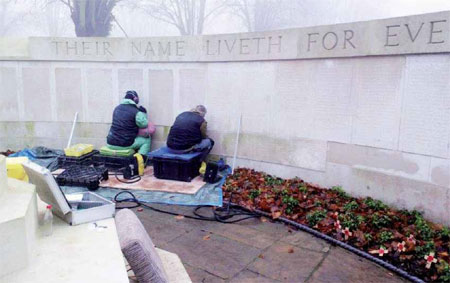
As the 100th anniversary of the outbreak of World War I nears, the story of thousands of Chinese laborers is being recalled
"Known unto God" reads the inscription on a war grave in West Flanders. Below it lie the remains of a man who was among 2,000 Chinese laborers who died in World War I and who are buried in cemeteries across Belgium and France.
The story of this man and tens of thousands of his compatriots who served in the war is known to few people, but it will be revived and told with many others when the centenary of World War I is marked from Aug 4 this year.
Ten million people died in the war, at least 600,000 in Belgium. More than 300,000 victims are buried in military cemeteries dotted around the Flemish countryside, but at least 200,000 are still missing.
In Flanders, preparations have been under way for years for commemorative activities, and a huge effort has been put into restoring the headstones of those who fell there, among them the 2,000 Chinese, who were members of the Chinese Labour Corps.
All the war graves are lovingly tended by staff of the Commonwealth War Graves Commission.
Lucy Donoughue, of the Imperial War Museum in London, says the corps was non-combatant but part of the British army and subject to military control. Its members carried out mainly manual tasks, building and repairing docks, roads, railways and airfields.
"It undertook much of the dangerous and unpleasant work of battlefield clearance," she says.
The rewards offered were tempting enough to encourage thousands of men, mainly poor peasants from the northern provinces of China, to offer themselves for three years' service.
In addition to a daily rate of pay much higher than most were used to, food, clothing, housing and medical support would be provided and the laborers' families would receive a regular separation payment until their return.
The first transport ship carrying 1,088 laborers sailed from Weihai in Shandong province in January 1917. The route took them across the Pacific to Vancouver, where they boarded a train for the week-long journey to Halifax, Nova Scotia.
Another ship took them across the Atlantic to Liverpool and from there to France. In all, the journey took three months. The Chinese quickly earned a reputation for hard work, ingenuity and improvisation.
By the end of 1917, there were 54,000 Chinese laborers with British Empire forces in France and Belgium, some of them recruited after China entered the war that August.
Peter Francis, a spokesman for the commission, says: "During that war, it was Chinese labor that built the ferry ports at Calais and Boulogne, and even in England, at Orford Ness in Suffolk, there remains a sea defense built to protect an important airfield and military base. Locally, it is still referred to as the Chinese Wall."
At war's end, the Chinese corps numbered nearly 96,000 (with a similar number serving with the French).
Of the nearly 2,000 men from the corps who died, some were killed as the direct result of enemy action or of wounds received in the course of their duties, but many more died in the influenza epidemic that swept Europe in 1918-19.
Chinese laborers who died were classified as war casualties, and Francis says great pains were taken to mark their graves in an appropriate way.
In addition to the laborer's name and date of death, each plot carries one of five standard dedicatory inscriptions. Countless other bodies were never identified and their graves bear the "Known unto God" inscription.
At Gwalia, one of the burial plots whose gravestone bears a name is that of Chang Fuh Eng, 24.
"The graves and cemeteries stand as permanent reminders of the Chinese presence in Europe during the war," Francis says.
As with many other World War I graves, those at Gwalia Cemetery are in a setting so serene and peaceful it is almost impossible to imagine the horrors that took place in the area nearly 100 years ago.
Horticulture is an essential part of the commemoration of the fallen, and this involves maintaining kilometers of headstone borders, hectares of turf and trees and shrubs in just about every type of soil and in every type of imaginable climate.

More Chinese corps members are buried just over the border in France, including the graves of 800 Chinese men at Noyelles-sur-Mer. This was the base depot for the Chinese Corps in France, the site of their largest camps and location of No. 3 General Labour Hospital.
The cemetery was used between April 1917 and March 1920, and in addition to the 800 Chinese buried there its memorial commemorates 40 more who died on land and sea.
Ruminghem Chinese Cemetery, near Calais, was the headquarters of No. 11 Labour Group and a Chinese hospital and contains 75 Chinese graves, half of them transferred from a cemetery at St Pol-sur-Mer after the war.
Not far away at Sangatte is Les Baraques, an important depot and hospital center during the war. The military cemetery there has more than 200 Chinese graves grouped together in what is called Plot 9.
For those involved in the painstaking restoration at cemeteries like Tyne Cot, Belgium, the clock is well and truly ticking to get the work completed in time to mark the start of the "war to end all wars".
Tyne Cot is the largest Commonwealth cemetery anywhere. The area was strategically important in the war, standing in the way of Germany's planned sweep into France from the north.
Wind and rain have worn down the surfaces of the 12,000 headstones at Tyne Cot and other cemeteries, rendering names hard to read. Some gravestones are chipped or cracked and the stones are no longer perfectly aligned. They are now being restored and re-engraved.
Xavier Nolens, one of the those doing the work, says it is painstaking and very time consuming.
"We have had teams traveling around our cemeteries engraving thousands of headstones and replacing them when they have reached the end of their useful life, over 15,000 at present."
At Menin Gate in West Flanders, where the Last Post is played every evening at 8 o'clock, a huge renovation project is under way. There are almost 54,000 names engraved in the walls there, each plaque bearing the name of some of those who fell in the area known as Ypres Salient and who have no known grave.
Tony Edwards, 49, a Briton, started working as a stonemason with the commission in 1988 and is now a supervisor in its northern Europe area.
"There are very few jobs in the world I think where you can actually be proud when you go home at night," he says. "You can be paid, but it's not the same feeling."
When he first joined the commission, his work included re-engraving headstones in situ as part of maintenance of all graves.
"You'd be sitting in a cemetery or laying down re-engraving a personal inscription and suddenly you get a tap on the shoulder from somebody.
"You look up, and they just say thank you. And for me that was probably the most rewarding job, that somebody had come, they could see what you're doing and your work was respected.
"You're bringing back that name, you're bringing back that personal inscription.
"In effect it felt that you're bringing back to life the memory, and the memory's the thing that's most important, I think, for everybody."
For China Daily

|
In war cemeteries and memorials across Belgium and northern France, a lot of the restoration work involves headstones and engravings. Photos Provided to China Daily |
|
The cemeteries and memorials are meticulously cared for by ground staff, stonemasons and others working for the Commonwealth War Graves Commission. Photos Provided to China Daily |
(China Daily Africa Weekly 03/07/2014 page24)








